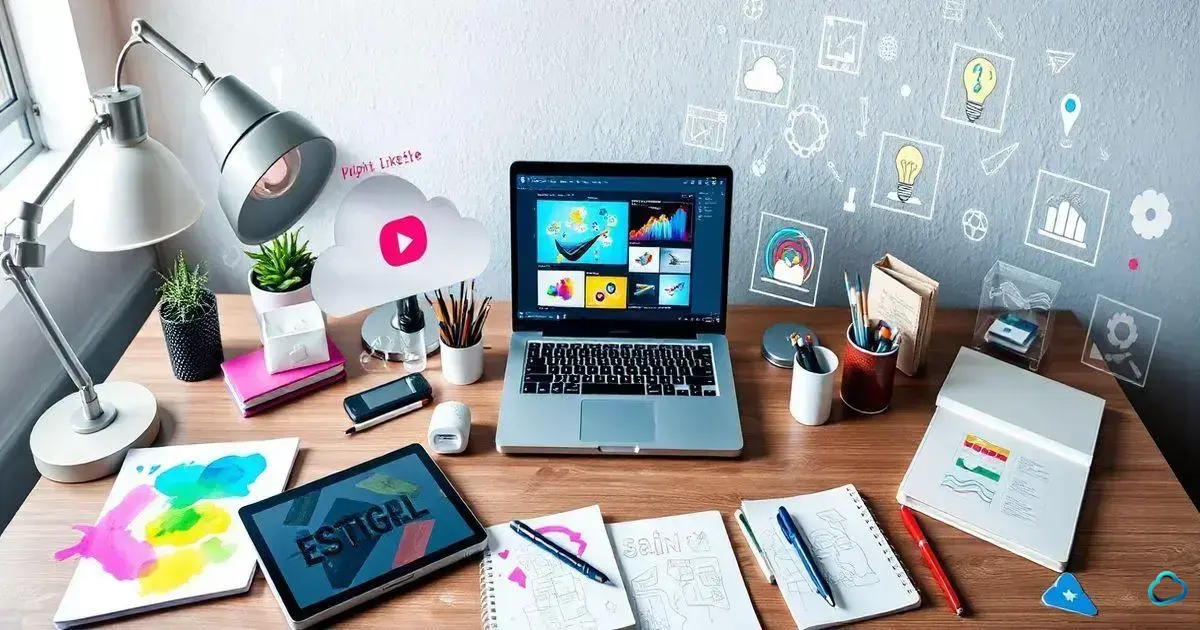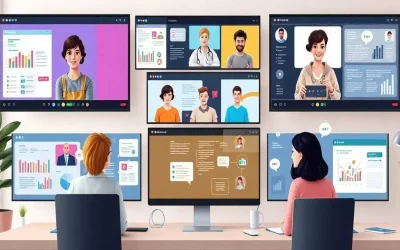Contents
- 1 1. Understanding SaaS Solutions
- 2 2. Benefits of Using Free SaaS Tools for Design
- 3 3. Top Free Design Tools for Graphic Design
- 4 4. Free SaaS Solutions for Project Management and Collaboration
- 5 6. How to Choose the Right Free SaaS Tool for Your Needs
- 6 Frequently Asked Questions about SaaS Tools for Design and Project Management
- 6.1 What are SaaS tools?
- 6.2 What are the benefits of using free SaaS tools for design?
- 6.3 Which free design tools are best for graphic design?
- 6.4 What free SaaS solutions are available for project management and collaboration?
- 6.5 What are some recommended free UI/UX design tools?
- 6.6 How do I choose the right free SaaS tool for my needs?
This guide explores the best free SaaS solutions for designers and creatives, emphasizing their role in enhancing productivity and creativity. It covers the benefits of using free tools, highlights top design applications like Canva and GIMP, and discusses project management tools such as Trello and Asana, along with UI/UX design options like Figma and Adobe XD. Ultimately, it advises users to assess their needs and test various options to find the right tools for their workflows.
In today’s competitive landscape, designers and creatives need access to the best tools to elevate their work without breaking the bank. Luckily, there are numerous Software as a Service (SaaS) solutions available that cater to the unique needs of professionals in this field. This guide will explore the best free SaaS solutions designed specifically for designers and creatives, helping you enhance your productivity and creativity without incurring any costs.
1. Understanding SaaS Solutions
Software as a Service (SaaS) is a cloud-based service where instead of downloading software on your desktop PC or business network to run and update, you instead access an application via your internet browser. This means your software is hosted remotely rather than being installed on your local hard drive.
SaaS solutions are designed to streamline your workflow. With applications accessible from any device with an internet connection, designers and creatives can work from anywhere, whether in the office, at home, or on the go. This flexibility is a game changer for those in creative fields that often require mobility.
One notable characteristic of SaaS is its subscription model. Users typically pay a monthly or annual fee for access to the software, which helps companies reduce upfront costs. However, many SaaS providers offer free versions or tiers, making powerful tools even more accessible to those just starting or looking to save on expenses.
Another advantage is the automatic updates that come with SaaS. Users don’t have to worry about manually installing patches or updates; the service provider ensures you always have the latest version of the software, equipped with the latest features and security measures.
In summary, understanding SaaS solutions is crucial for designers and creatives looking to enhance their productivity. By leveraging these tools, professionals can focus more on their creative processes rather than getting caught up with software installation and maintenance.
2. Benefits of Using Free SaaS Tools for Design

Free SaaS tools offer a variety of benefits specifically tailored to the needs of designers and creatives. One of the primary advantages is the cost savings. With these tools, professionals can access high-quality software without the burden of subscription fees, allowing them to allocate their budget to other essential aspects of their projects or business.
Collaboration is another key benefit. Many free SaaS tools include features that facilitate teamwork, allowing multiple users to work on projects simultaneously. This is particularly valuable for design teams or freelancers collaborating with clients, as it fosters real-time feedback and reduces the time spent on email exchanges.
Moreover, free SaaS tools are often user-friendly and designed for quick learning. This means designers can get up to speed quickly without extensive training or onboarding, enabling them to focus on their creative tasks rather than navigating complex software interfaces.
Additionally, these tools typically feature cloud storage and accessibility. Designers can access their projects from any device with an internet connection, whether they are working from a desktop in the office or on a laptop at a café. This mobility is vital in today’s fast-paced work environment, giving creatives the freedom to work wherever inspiration strikes.
Finally, the community aspect of many free SaaS tools cannot be overlooked. Popular tools often have robust user communities and support systems. This allows designers to connect with others, share tips, and find creative solutions to common challenges, further enhancing their design capabilities.
3. Top Free Design Tools for Graphic Design
When it comes to graphic design, having the right tools at your disposal can significantly impact your work quality and efficiency. Here are some of the top free design tools that every graphic designer should consider:
Canva is a user-friendly graphic design tool that allows you to create stunning visuals for social media, marketing materials, and more. With thousands of templates and an intuitive drag-and-drop interface, Canva is ideal for both beginners and experienced designers who want to save time.
GIMP (GNU Image Manipulation Program) is a powerful open-source graphic design software that offers features similar to Adobe Photoshop. It’s suitable for tasks such as photo retouching, image composition, and image authoring, making it a great alternative for professional designers seeking a free tool.
Inkscape is a free vector graphics editor that’s perfect for creating logos, illustrations, and complex designs. Unlike raster-based software, Inkscape allows you to create designs that can be resized without losing quality, making it an excellent choice for graphic designers focused on scalability.
Adobe Spark is a suite of design tools that helps users create graphics, web pages, and short videos quickly and easily. The free version offers a range of templates, fonts, and stock photos, making it an excellent resource for busy designers who need to create content rapidly.
Vectr is a free vector graphics editor that operates both online and offline. It’s designed for simplicity and ease of use, allowing users to create sharp graphics and detailed illustrations with minimal learning curve. Ideal for designers who are new to vector graphics.
4. Free SaaS Solutions for Project Management and Collaboration

Effective project management and collaboration are crucial for designers and creatives who often work on multiple projects simultaneously. Utilizing free SaaS solutions can streamline workflows and enhance communication among team members. Here are some of the best free tools available for project management and collaboration:
Recommended Project Management Tools for Creatives
Trello is a visual project management tool that uses boards, lists, and cards to help users organize tasks and workflows. Its intuitive interface makes it easy to track project progress and collaborate with team members. The free version offers essential features for individual users or small teams, making it ideal for straightforward task management.
Asana is a task management platform designed to help teams track their work and manage projects effectively. The free version includes features like task assignments, due dates, and project timelines, making it a great solution for creatives managing collaborative projects with multiple contributors.
Slack is a messaging platform that fosters real-time communication among team members. It offers features such as channels, direct messaging, file sharing, and integrations with other tools, enhancing collaboration for remote teams of designers and creatives. Slack’s free plan is ideal for smaller teams looking to improve communication and streamline workflows.
Notion combines notes, databases, kanban boards, and calendars into a single workspace. It allows teams to collaborate on projects, manage tasks, and document processes all in one place. The free version is available for individual users and small teams, making it a versatile tool for both personal and professional project management.
ClickUp is a comprehensive project management tool that integrates tasks, docs, goals, and chat into one platform. The free version includes essential features that allow teams to manage tasks efficiently, making it an excellent choice for creatives aiming to streamline their workflow and enhance productivity.
These tools offer powerful features and free plans tailored to meet the needs of individuals and small teams. Whether you’re managing simple tasks or complex projects, these platforms can help you stay organized and collaborate effectively.
5. Best Free UI/UX Design Tools
Best Free UI/UX Design Tools for Engaging Digital Experiences
Figma is a popular web-based design tool that allows for collaborative UI/UX design. The free version offers robust features such as vector graphics editing, prototyping, and real-time collaboration, making it a favorite among teams working together to create user interfaces.
Adobe XD is a vector-based design tool for creating wireframes, prototypes, and screen designs. The free starter plan includes design and prototyping features, making it an excellent choice for designers who want to experiment with UI/UX projects without a financial commitment.
InVision provides a powerful platform for prototyping and collaboration. The free version allows users to create clickable prototypes and gather feedback, which is invaluable for refining UI/UX designs based on user input and collaboration.
Sketch (Free Trial): While Sketch is primarily a paid tool, it offers a free trial version. This vector-based design tool is particularly popular among UI designers for its extensive range of plugins and components. The trial version allows users to explore its features before committing to a subscription.
UXPin is a high-fidelity wireframing and prototyping tool that enables designers to create interactive prototypes. Its free version is ideal for those who want to experiment with user flow and design concepts, enhancing their understanding of user experience.
These tools offer excellent options for UI/UX designers seeking to improve their projects without incurring significant costs. Whether you’re creating wireframes, prototypes, or full designs, these platforms provide the necessary features to elevate your design process.
6. How to Choose the Right Free SaaS Tool for Your Needs

Selecting the right free SaaS tool can significantly impact your productivity and the quality of your work as a designer or creative. Here are some key considerations to help you choose the best tool for your specific needs:
Assess Your Requirements: Begin by identifying the specific tasks you’ll need the tool for. Whether it’s graphic design, project management, or UI/UX design, defining your requirements will help you narrow down your options.
Evaluate User Experience: Look for tools with intuitive interfaces and easy navigation. A user-friendly tool saves you time while allowing you to focus on your creative work rather than struggling with complicated software.
Check Collaboration Features: If you work in teams, prioritize tools that offer robust collaboration features. Look for options that allow real-time editing, commenting, and task assignments to enhance teamwork and communication.
Consider Integration Capabilities: Select tools that can seamlessly integrate with other software you already use. This could include design software, project management platforms, or communication tools, which can streamline your workflow.
Look for Customer Support and Documentation: Having access to reliable customer support and thorough documentation can be crucial, especially when learning a new tool. Consider tools that offer tutorials, community forums, and responsive customer service.
Test Multiple Options: Take advantage of free trials and versions to test different tools before committing. This hands-on experience will allow you to assess which tool aligns best with your workflow and creative process.
In conclusion, the availability of free SaaS solutions has greatly empowered designers and creatives by providing easy access to essential tools that enhance productivity, collaboration, and design quality.
By understanding the unique benefits of these tools—from project management platforms to robust design software—creatives can streamline their workflows and focus on what truly matters: producing exceptional work.
Choosing the Right Tool
When choosing the right tool, it’s vital to assess your specific needs, evaluate user experience, and test multiple options to find the perfect fit for your creative projects.
By leveraging these tools, designers can elevate their work, engage effectively with teams, and ultimately drive better outcomes in their projects.
Frequently Asked Questions about SaaS Tools for Design and Project Management
What are SaaS tools?
SaaS tools, or Software as a Service tools, are cloud-based applications that users access via a web browser instead of installing software on their local machines. They often operate on a subscription model but many providers offer free versions.
What are the benefits of using free SaaS tools for design?
Free SaaS tools offer significant cost savings, facilitate collaboration among teams, provide user-friendly interfaces for quick learning, enable access from any device with internet connectivity, and often come with active user communities for support and sharing tips.
Which free design tools are best for graphic design?
Some of the top free design tools for graphic design include Canva, GIMP, Inkscape, Adobe Spark, and Vectr. Each of these tools offers unique features tailored to various design tasks.
What free SaaS solutions are available for project management and collaboration?
Great free SaaS solutions for project management and collaboration include Trello, Asana, Slack, Notion, and ClickUp. These tools help teams manage tasks, enhance communication, and streamline project workflows.
What are some recommended free UI/UX design tools?
Popular free UI/UX design tools include Figma, Adobe XD, InVision, UXPin, and the trial version of Sketch. They each provide essential features for creating user interfaces and prototypes.
How do I choose the right free SaaS tool for my needs?
To choose the right free SaaS tool, assess your specific requirements, evaluate user experience, check for collaboration features, consider integration capabilities, look for customer support and documentation, and test multiple options through free trials.





